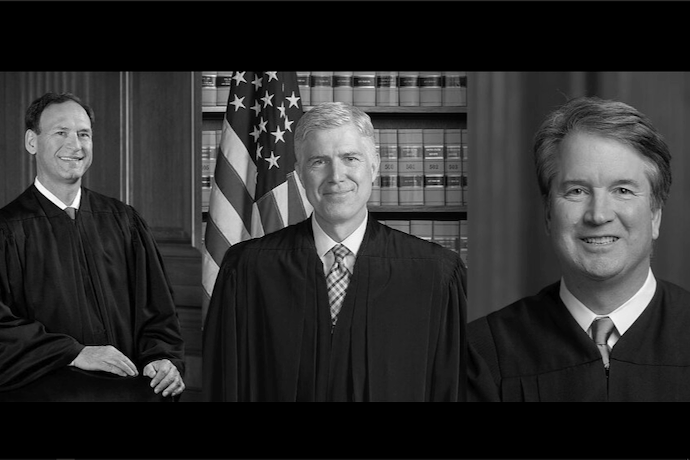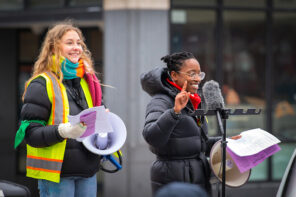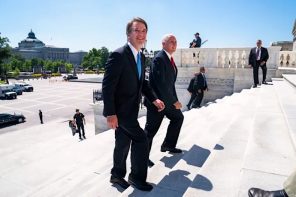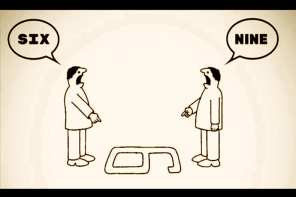The unsigned, midnight opinion dropped like a bombshell on Thanksgiving. Five ultraconservative members of the Supreme Court, including Amy Coney Barrett, issued an emergency opinion in Roman Catholic Diocese of Brooklyn v. Cuomo blocking New York’s health order as it applied to some churches.
The metaphorical bombardment is particularly apt here because this opinion weaponized religious freedom and came as something of a surprise to the country—though of course it shouldn’t have been.
Just a few weeks ago, I warned that Barrett would “flip the high court on an issue that is crucial for America to fight the coronavirus, just as the pandemic is flaring up. Barrett telegraphed a willingness to overturn public health measures in the name of God.” If RBG had been alive and on the court it would have been a 5-4 decision the other way.
The short, unsigned opinion, joined by Thomas, Alito, Gorsuch, Kavanaugh and Barrett, stated that churches’ right to religious freedom includes the right to risk the health, safety, and lives of everyone in the community. The justices took a hallowed constitutional protection and made it into a tool to afflict and wound—beating a plowshare into a sword. To do this, the justices made this into a case of religious discrimination. That is simply not the case. The justices had to torture the facts and sought to create an impression of discrimination where there was none.
They complained variously that hardware stores, acupuncturists, liquor stores, bicycle repair shops, accountants, lawyers and insurance agents were open with fewer capacity restrictions than churches. But most of these are one-on-one businesses that require little to no face time with customers. As an attorney, I’ve been remote without issue since February.
Religious worship is different. People gather in large numbers, indoors, close together, file in and out in crowds, and sing and pray and chant—all of which help spread the virus. We know that churches spread this virus. One worshipper in Ohio infected nearly 100 other people, half of whom never stepped foot in the church. It spread, “like wildfire,” said Ohio Republican Gov. Mike DeWine. And that was in early August, before things got really bad.
At one point in South Korea, half of the country’s cases were traced back to religious worship.
That’s because churches are different from liquor stores or bike repair shops or even a one-on-one acupuncture appointment. They’re more like going to a movie, or taking in a play, or listening to a lecture, or watching an indoor sporting event. All of those were banned under the New York orders that the churches were complaining about. Churches, however, were still allowed to meet, 10 or less, and then 25 or less depending on which zone they were in.
So when you compare apples to apples, churches were actually already favored under the stay-at-home orders. They were given special privileges. But that was apparently not enough. They cried discrimination because they weren’t given the most favorable treatment available—a decision made entirely to protect the public and save lives, and not on the basis of religion, but on the basis of other characteristics relating to the spread of a lethal virus. And five of the six members of the court’s conservative bloc agreed that it was discrimination.
Roberts rebuke
Much is also being made of the public spat between Chief Justice Roberts and Justice Neil Gorsuch in the case. Too much.
Gorsuch attacked Roberts, almost by name, for giving in to a “judicial impulse to stay out of the way in times of crisis” and trying to “shelter in place when the Constitution is under attack.” Roberts’ retort was withering in its simplicity. Roberts began his dissent, “I would not grant injunctive relief under the present circumstances. There is simply no need to do so. After the Diocese and Agudath Israel filed their applications, the governor revised the designations of the affected areas.” In other words, the orders in the emergency request no longer applied to the churches or synagogues. Roberts summed it up, “An order telling the governor not to do what he’s not doing” is not something the court should be issuing.
But people are giving Roberts too much credit here. He might even be on board with the decision on the constitutional question, writing, “it may well be that such restrictions violate the Free Exercise Clause.” Justice Brett Kavanaugh noted his line in his concurrence. The rift between Roberts and the other five conservatives is not ideological; he’s still an archconservative. The split is about how to implement the conservative agenda.
Roberts wants to move slowly to help preserve the legitimacy of the court and thereby preserve the legitimacy of the changes. Justices Clarence Thomas and Samuel Alito have chafed for more than a decade at this incrementalism, and with three new Trump justices, they need hold back no more. This was a rebellion against Roberts pumping the brakes on conservative change, but they still agree on the need for that change.
Roberts’ vote no longer matters. There are five unrestrained conservative activists. Roberts no longer holds a leash. “Cry ‘havoc!’ and let slip the dogs of war” seems a tame way to express the decisions we’ll see coming from this court, especially in cases where they might further morph religious freedom into religious privilege.
The shockwaves from this bomb will echo for a long time. Americans will suffer, both from COVID and shutdowns. Essentially, the five justices have made it so that if governments want to stop the spread, they have to shut everything down. Not only will they suffer, but Americans will die because these five justices see religious freedom as a license to exempt believers from laws.





